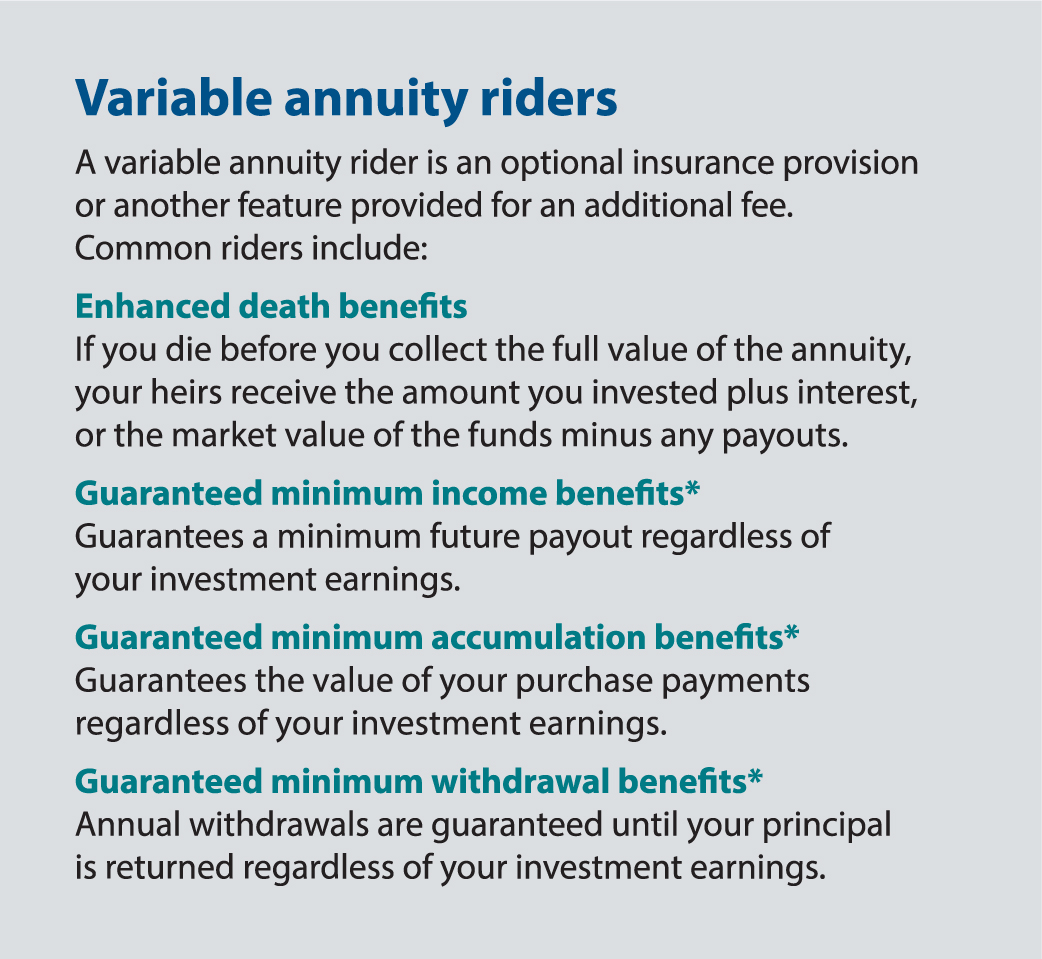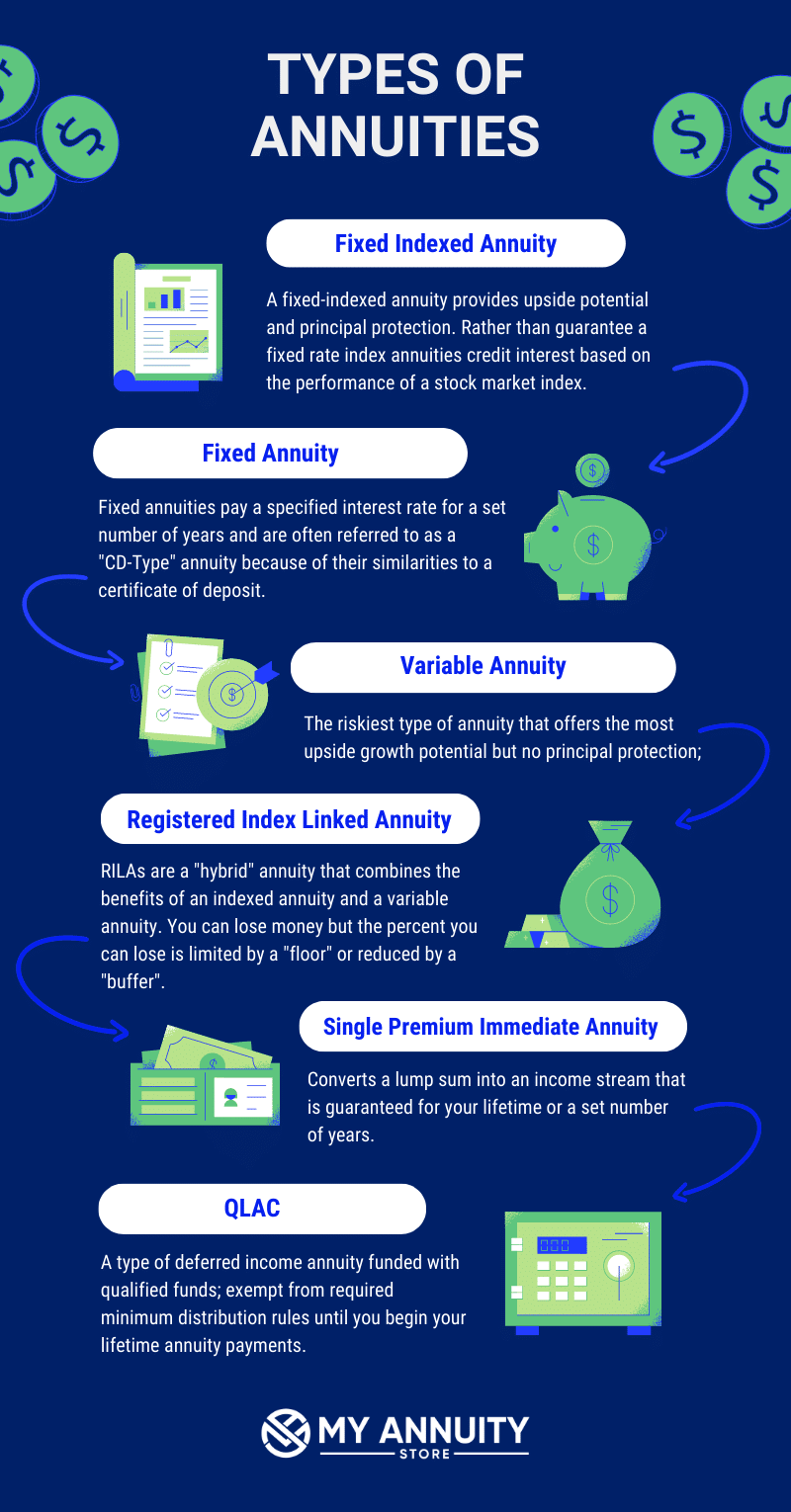All Categories
Featured
Table of Contents
The repayment may be invested for development for an extended period of timea single costs deferred annuityor spent momentarily, after which payout beginsa single premium immediate annuity. Single costs annuities are often moneyed by rollovers or from the sale of a valued property. A flexible premium annuity is an annuity that is meant to be moneyed by a collection of payments.
Proprietors of repaired annuities understand at the time of their acquisition what the worth of the future capital will certainly be that are created by the annuity. Certainly, the number of capital can not be recognized beforehand (as this relies on the contract proprietor's life expectancy), but the assured, taken care of rates of interest at the very least provides the proprietor some level of certainty of future income from the annuity.
While this difference appears straightforward and simple, it can considerably affect the worth that an agreement owner eventually stems from his/her annuity, and it develops considerable uncertainty for the contract proprietor - Tax-deferred annuity benefits. It likewise normally has a material influence on the level of fees that an agreement proprietor pays to the releasing insurance coverage firm
Set annuities are often used by older financiers that have limited possessions however who wish to offset the threat of outlasting their possessions. Fixed annuities can work as an effective tool for this function, though not without certain disadvantages. For instance, when it comes to immediate annuities, once a contract has been purchased, the agreement owner relinquishes any and all control over the annuity possessions.
Highlighting the Key Features of Long-Term Investments A Comprehensive Guide to Variable Vs Fixed Annuities What Is the Best Retirement Option? Pros and Cons of Various Financial Options Why Immediate Fixed Annuity Vs Variable Annuity Can Impact Your Future Fixed Index Annuity Vs Variable Annuity: Explained in Detail Key Differences Between Different Financial Strategies Understanding the Rewards of Immediate Fixed Annuity Vs Variable Annuity Who Should Consider Fixed Interest Annuity Vs Variable Investment Annuity? Tips for Choosing Retirement Income Fixed Vs Variable Annuity FAQs About Fixed Income Annuity Vs Variable Growth Annuity Common Mistakes to Avoid When Planning Your Retirement Financial Planning Simplified: Understanding Your Options A Beginner’s Guide to Smart Investment Decisions A Closer Look at How to Build a Retirement Plan
A contract with a typical 10-year abandonment duration would charge a 10% abandonment charge if the contract was surrendered in the first year, a 9% abandonment cost in the second year, and so on till the abandonment charge reaches 0% in the agreement's 11th year. Some delayed annuity contracts consist of language that enables small withdrawals to be made at numerous intervals throughout the surrender period without fine, though these allocations usually come at an expense in the form of lower guaranteed rates of interest.
Just as with a repaired annuity, the owner of a variable annuity pays an insurer a round figure or collection of repayments in exchange for the assurance of a series of future payments in return. Yet as stated over, while a fixed annuity expands at an ensured, constant rate, a variable annuity grows at a variable rate that relies on the performance of the underlying investments, called sub-accounts.
During the build-up stage, properties purchased variable annuity sub-accounts expand on a tax-deferred basis and are taxed just when the contract proprietor withdraws those revenues from the account. After the buildup stage comes the income stage. In time, variable annuity properties ought to in theory boost in worth until the agreement owner determines he or she want to begin taking out cash from the account.
The most considerable problem that variable annuities generally existing is high cost. Variable annuities have several layers of charges and expenditures that can, in aggregate, create a drag of up to 3-4% of the contract's value each year.
M&E cost fees are determined as a percent of the contract worth Annuity issuers pass on recordkeeping and other management expenses to the agreement owner. This can be in the type of a flat yearly charge or a percent of the contract worth. Management fees may be included as part of the M&E danger fee or may be assessed individually.
These costs can range from 0.1% for passive funds to 1.5% or more for proactively taken care of funds. Annuity agreements can be personalized in a variety of ways to serve the details requirements of the contract proprietor. Some typical variable annuity riders consist of ensured minimum accumulation benefit (GMAB), guaranteed minimum withdrawal advantage (GMWB), and ensured minimum revenue benefit (GMIB).
Analyzing Fixed Indexed Annuity Vs Market-variable Annuity A Comprehensive Guide to Tax Benefits Of Fixed Vs Variable Annuities Defining Fixed Vs Variable Annuity Pros And Cons Advantages and Disadvantages of Different Retirement Plans Why Choosing the Right Financial Strategy Matters for Retirement Planning How to Compare Different Investment Plans: Simplified Key Differences Between Different Financial Strategies Understanding the Risks of Fixed Vs Variable Annuity Who Should Consider Annuities Fixed Vs Variable? Tips for Choosing the Best Investment Strategy FAQs About Fixed Vs Variable Annuity Pros Cons Common Mistakes to Avoid When Choosing Deferred Annuity Vs Variable Annuity Financial Planning Simplified: Understanding Fixed Income Annuity Vs Variable Annuity A Beginner’s Guide to Smart Investment Decisions A Closer Look at How to Build a Retirement Plan
Variable annuity payments provide no such tax obligation deduction. Variable annuities often tend to be extremely ineffective vehicles for passing wide range to the future generation due to the fact that they do not enjoy a cost-basis modification when the original agreement proprietor passes away. When the owner of a taxed financial investment account passes away, the expense bases of the investments held in the account are adapted to reflect the marketplace prices of those investments at the time of the owner's fatality.
Such is not the case with variable annuities. Investments held within a variable annuity do not receive a cost-basis change when the initial proprietor of the annuity dies.

One considerable concern connected to variable annuities is the capacity for disputes of rate of interest that may exist on the part of annuity salespeople. Unlike a monetary advisor, that has a fiduciary obligation to make investment decisions that profit the customer, an insurance broker has no such fiduciary commitment. Annuity sales are extremely lucrative for the insurance professionals who sell them due to the fact that of high ahead of time sales compensations.
Lots of variable annuity agreements have language which places a cap on the percentage of gain that can be experienced by specific sub-accounts. These caps avoid the annuity owner from completely participating in a section of gains that could or else be enjoyed in years in which markets create considerable returns. From an outsider's perspective, presumably that investors are trading a cap on financial investment returns for the abovementioned guaranteed floor on investment returns.
Decoding Variable Annuities Vs Fixed Annuities Everything You Need to Know About Variable Annuities Vs Fixed Annuities What Is the Best Retirement Option? Features of Annuities Variable Vs Fixed Why Indexed Annuity Vs Fixed Annuity Can Impact Your Future Fixed Index Annuity Vs Variable Annuities: How It Works Key Differences Between Variable Vs Fixed Annuity Understanding the Risks of Fixed Index Annuity Vs Variable Annuity Who Should Consider Strategic Financial Planning? Tips for Choosing the Best Investment Strategy FAQs About Fixed Indexed Annuity Vs Market-variable Annuity Common Mistakes to Avoid When Choosing Annuity Fixed Vs Variable Financial Planning Simplified: Understanding Your Options A Beginner’s Guide to Smart Investment Decisions A Closer Look at How to Build a Retirement Plan
As noted above, surrender costs can severely limit an annuity owner's capacity to relocate assets out of an annuity in the very early years of the agreement. Better, while most variable annuities allow contract proprietors to take out a defined amount throughout the buildup stage, withdrawals beyond this amount usually cause a company-imposed cost.
Withdrawals made from a fixed rates of interest investment choice can additionally experience a "market worth change" or MVA. An MVA changes the value of the withdrawal to show any kind of changes in rates of interest from the time that the money was bought the fixed-rate choice to the moment that it was taken out.

Rather typically, even the salesmen that offer them do not totally recognize exactly how they work, therefore salespeople in some cases victimize a customer's emotions to offer variable annuities rather than the advantages and suitability of the items themselves. Our company believe that investors should completely recognize what they own and just how much they are paying to own it.
The exact same can not be said for variable annuity possessions held in fixed-rate financial investments. These properties legitimately come from the insurance provider and would certainly for that reason go to threat if the company were to fall short. Any kind of guarantees that the insurance policy firm has agreed to supply, such as an ensured minimum earnings benefit, would be in inquiry in the occasion of an organization failing.
Analyzing Choosing Between Fixed Annuity And Variable Annuity A Comprehensive Guide to Choosing Between Fixed Annuity And Variable Annuity What Is Tax Benefits Of Fixed Vs Variable Annuities? Advantages and Disadvantages of Different Retirement Plans Why Choosing the Right Financial Strategy Can Impact Your Future What Is Variable Annuity Vs Fixed Annuity: How It Works Key Differences Between Variable Vs Fixed Annuity Understanding the Key Features of Long-Term Investments Who Should Consider Fixed Income Annuity Vs Variable Annuity? Tips for Choosing What Is A Variable Annuity Vs A Fixed Annuity FAQs About Annuity Fixed Vs Variable Common Mistakes to Avoid When Choosing Fixed Vs Variable Annuity Pros And Cons Financial Planning Simplified: Understanding Your Options A Beginner’s Guide to Smart Investment Decisions A Closer Look at How to Build a Retirement Plan
Therefore, prospective buyers of variable annuities ought to understand and think about the financial problem of the providing insurance provider before participating in an annuity contract. While the benefits and disadvantages of various kinds of annuities can be disputed, the real issue bordering annuities is that of suitability. Place simply, the concern is: that should possess a variable annuity? This question can be hard to answer, offered the myriad variants available in the variable annuity cosmos, but there are some basic standards that can assist financiers choose whether or not annuities should contribute in their financial strategies.
Nevertheless, as the claiming goes: "Caveat emptor!" This short article is prepared by Pekin Hardy Strauss, Inc. ("Pekin Hardy," dba Pekin Hardy Strauss Wide Range Management) for informational objectives only and is not planned as an offer or solicitation for business. The details and information in this short article does not make up lawful, tax obligation, accounting, financial investment, or other specialist suggestions.
Table of Contents
Latest Posts
Analyzing Variable Annuity Vs Fixed Indexed Annuity Everything You Need to Know About Fixed Income Annuity Vs Variable Annuity Defining the Right Financial Strategy Advantages and Disadvantages of Fix
Breaking Down Variable Vs Fixed Annuities Key Insights on Fixed Index Annuity Vs Variable Annuity Defining Fixed Vs Variable Annuity Benefits of Fixed Index Annuity Vs Variable Annuity Why Choosing th
Understanding Variable Vs Fixed Annuities Key Insights on Variable Vs Fixed Annuities Defining Immediate Fixed Annuity Vs Variable Annuity Pros and Cons of Indexed Annuity Vs Fixed Annuity Why Choosin
More
Latest Posts